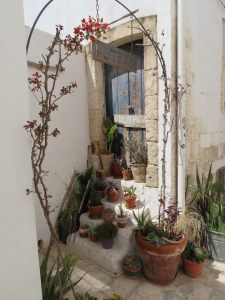
Growing cactus must be one of the reasons there are so many varieties in Southern Italy.
In Part 5, we discovered Lecce Baroque is an attitude as much as an architectural style and that certified organic wines go down easily with a farm-to-table fresh meal wonderfully prepared.
The last city on this two-week Odysseys Unlimited tour of Sicily and Southern Italy came sooner than it seemed possible. That’s the way it is with all vacations, I expect, but sometimes the days melt faster into the next depending on activities and on the group’s personal dynamics. This 18-member group has been exceptionally harmonious, so the shared experiences have flashed by. Nonetheless, we are headed to Sorrento, a city Russ and I visited with Odysseys four years ago. Then we had mere hours in Sorrento, but an unmistakable allure demanded a lengthier stay.
Our bus followed the highway past Ostuni. Bright sun bounces off the medieval city’s all white buildings as if it’s a Hollywood premiere and Klieg lights are strobing the night sky.
We pause in Polignano a Mare. The city’s claim to fame is that it was home to Domenico Modugno, the singer/songwriter for “Volare”. The song may have only won third place in 1956’s Eurovision but it still became a global megahit despite the words having no great meaning. The song words don’t mean a lot. (“Volare, oh, oh!; Cantare, oh, oh, oh, oh!” are the only words I have ever known.) Volare means flying. Cantare means singing.
We left the Apulia/Puglia region and arrived in Campania. The northern section of Campania is known for tomatoes. The red Aglianico and the white Falanghina grapes dominate wine production. These two varieties compose more than 75% of the Benevento IGT wines produced.
This region is also known for genuine buffalo mozzarella, considered white gold. The cheese is exclusively made from water buffalo milk. Calling other cheese buffalo mozzarella when not made from Campania’s water buffalo milk is akin to referring to bubbly not from Champagne, France as champagne.
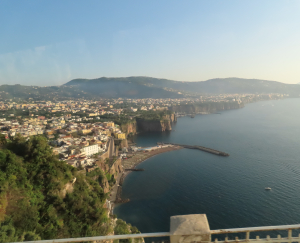
The Amalfi Coast is densely populated.
We left behind blighted olive trees. Rolling green hills have given way to more hilly juts before finally ceding to the Apennine Mountain range. Neon yellow flowers have become a faded memory now jolted by bursts of red poppies.
There are about five million people in Campania, with most of them huddled in two areas closer to Naples and Salerno along the Tyrrhenian Sea, the arm of the Mediterranean Sea between the western coast of Italy and the islands of Corsica, Sardinia, and Sicily.
One of the most visited and famous areas of this part of Italy is the Amalfi coast, which rides the edge of the Bay of Naples. The city of Naples, once one of the most prosperous cities in Italy, became one of the most financially poor in the European Union, due in large part to organized crime and corruption.
SORRENTO
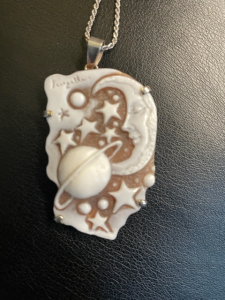
Russ bought me this cameo carved from a single shell in Sorrento.
Four years ago, Russ and I had been to Sorrento as part of Odysseys Unlimited’s Portrait of Italy* tour. Although we had but a few hours to tour and shop our then Tour Director had taken us to a small three-person shop called Bimonte, where shells are hand carved into many designs. Russ bought me a stunning celestial-themed necklace carved from a shell with multiple layers of shaded colors. Even though the shops’ designs are not what I think of as a cameo design, that’s what their pendants are called. What make the designs from Bimonte unique is that the back of the pendant replicates the design of the front, but in silver.
After nearly everyone bought jewelry from Bimonte, we scurried through the crowds packed between vender booths showcasing Moroccan, Arabic, and Spanish products. There was no time to do more than quickly glance at bright colored fabrics and dangling mosaic hanging lights. This time we were determined to see what Sorrento was really like.
where we stayed:
This tour was made even more enjoyable because we only stayed in four hotels during the two weeks. We have been on trips that traverse a wider area or more than one country. The sightseeing is fantastic and not easily replicated by oneself, but it is tiring having to pack and unpack every two or three days. Even though Hotel Antiche Mura sits in the heart of Sorrento’s activity, the manicured grounds, garden and pool area, and separate glass teahouse for the breakfast buffet was a serene respite. There are 52 rooms total, with some in the main building and many individually sized and uniquely decorated rooms in the building abutting the garden.
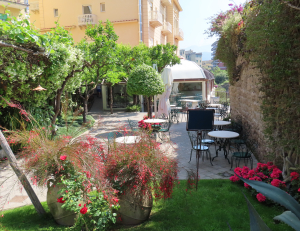
Outside the breakfast room at Hotel Antiche Mura is a flower-potted path to the gardens and more guest rooms.
The historic hotel resides near Piazza Tasso, the main square that is a short walk away. The hotel has its own citrus grove, which supplies all the oranges and lemons used by the kitchen and bar. The AC runs from May through October. Between the breakfast room and its outside patio tables and the pool area, you pass by a deep gorge sheltered by a fortification wall separating the hotel grounds from the highway.

The view from our room was a slice of real life.
One more interesting point about this property is that it is surrounded by residential apartments. Our room overlooked the slim alleyway that runs in front of the residences. If I stepped out on the foot-wide ledge I could watch laundry being hung, motorcyclists roaring by at a speed I wouldn’t think safe in the twisting curved passages, and I could hear families calling out for dinner. This connection to people living their everyday lives became important to me at the end of the trip in ways I’d not pondered before then.
Now that we’ve been to four hotels on this trip, I observed that all have croissants in chocolate, cream or apricot filled, but no almond, even though almonds are prevalent in Southern Italy. The buffets all have mozzarella, Emmenthal, fruit, juices (though some are from concentrate), runny scrambled eggs, cereals, and mini rolls in plain or grains.
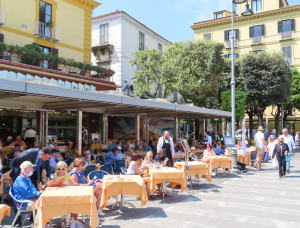
Dining outside in Sorrento is easy when there are so many choices.
How coffee is served varies widely, from the restaurant in Matera where you must be seated for the server to approach and ask for your coffee order to this one where a small pot is brought to each person at the table. In Sicily’s Eurostars Monte Tauro, there were two coffee machines accessible for the entire restaurant, which could have seated more than 100. To get a café Americano (larger quantity than an espresso), you’d have to hit the icon more than once, so not a quick fix. At Mercure Hotel President Lecce, coffee was self-serve from multiple pots sitting on warmers. I also noted that at each property, bathrooms were equipped with small bars of soap, something you don’t always get in other European hotels. What I didn’t see, which surprised me, is that not all our hotel rooms had boxes of tissues. As someone plagued by allergies, a box of Kleenex is a necessity.
what we did:
While the rest of our 18-member tour group headed to Pompeii and an add-on side trip to the Archaeological Park of Herculaneum, Russ and I slept in, strolled through Sorrento, had a light lunch, and browsed shops. COVID and immigrant rules had altered the landscape. This time vendors hawked souvenirs and more generic goods, so we bought nothing, but we did enjoy people watching. What I didn’t want to miss was the cooking class and dinner we were going to that evening just outside the city at a working farm.

The natural beauty of the Isle of Capri.
Russ and I had been to Pompeii on the Portrait of Italy trip four years ago. I’d written about it extensively.* Reports from those who went this time thought Herculaneum more startling than Pompeii. They said future Odysseys trips to Italy should include both.
Russ was eager to visit the Isle of Capri, especially once he realized we’d be there longer than first thought. The name sounds much more romantic than its translation, which is a feminine Italian name for goat or wild boar. Although many movies and TV shows have filmed here, the Isle of Capri’s beginnings were more of a snatch and grab. Allegedly, Emperor Augustus grabbed it from Naples and built a palace there to establish his presence. After him, it was Tiberius who claimed the island and ruled the empire from there. In AD 27, Tiberius finished Villa Jovis, one of 12 villas he built. That villa is still protected and preserved as a museum.

One of the many grotto entrances on the Isle of Capri.
We arrived at Marina Grande on the Isle of Capri via an hour-long hydrofoil ride, grateful the sea was calm. The water is a stunning blue. Bright sun reflected off the limestone. Cliffs are craggy and pockmarked. There are pockets of trees. We did not take one of the guided rowboats into the Emerald Grotto, which is similar in size to the Blue Grotto, a famous natural attraction known for its bright blue waters. We inquired at the waiting line of boats and were told they might idle for several hours before transferring two passengers at a time into small rowboats which would then enter the grotto for brief minutes. The Blue Grotto is illuminated by the sunlight passing through an underwater cavity, but artificial light is used to illuminate the Emerald Grotto.
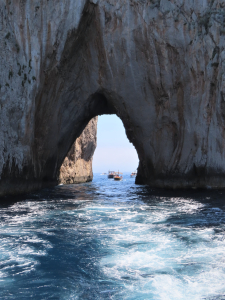
You’re supposed to kiss someone special when passing through the Arch of Love. I did!
We bypassed the Blue Grotto but did not miss out on passing through the Arch of Love, a large natural hole inside an arched rock in the water. Legend has it that when you pass through the arch, you’re supposed to kiss someone special. Some of us took that more seriously than others!
Once on the Isle of Capri, we explored the city’s curving rise-and-fall roads that aren’t much bigger than golf cart paths before reaching the terraced Gardens of Augustus. The gardens were created by German industrialist, Friedrich Alfred Krupp when he was building his mansion in the early 20th century. They were called Krupp Gardens until 1918, when renamed Gardens of Augustus. From the top of the gardens, there is a 360-degree photo op of the island’s full beauty.
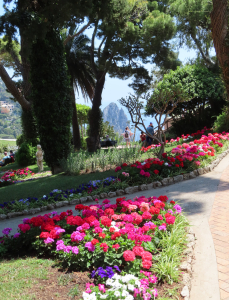
Walking in the beauty of the Gardens of Augustus.
We learned there is only one road up to Anacapri, the second-largest settlement on the island. It’s also known as the Mamma Mia Road because it is so narrow and high that when people look down, the first thing said is, “Mamma Mia, what am I doing here?” There wasn’t time to visit Anacapri, so we chose instead to enjoy an elegant lunch in the lush surroundings at Restorante Il Geranio Capri with our friends Vivian and Dave W.
The first time we toured Italy we stayed in the fantastic 37-room Marmorata Hotel, hovering the cliffs of the Amalfi Coast.** This time we were bussing in from Sorrento for a morning visit.
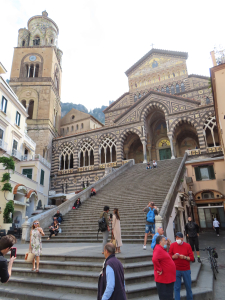
The Amalfi Cathedral is a marvel of beauty and craftsmanship.
The distance from Sorrento to the Amalfi Coast is only 18 miles, but the time to get there depends totally on traffic, which is often bumper-to-bumper. After our first experience driving on the Amalfi Coast in a large tour bus, Russ and I do not understand why anyone not a local would venture to drive on those stomach-dropping miniscule curves and with local etiquette rules of the road. It was originally built in the 1830s by the Bourbons and I doubt there have been many upgrades.
Our group left for the Amalfi Coast particularly early because new government rules said all busses had to be gone from the area by late morning so they could control tourist crowds.
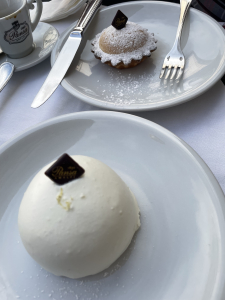
Two signature desserts in Amalfi are the iced round lemon almond cake and the lemon tart dusted with confectionary sugar.
We hurried though the town, recalling our first visit. There was the little shop near the gated entrance that gave us our first taste of local limoncello. We remembered Amalfi makes a brand of specialized paper from lemons used exclusively by well-known paper mâché artists. We did rest long enough to buy the famous local iced round lemon almond cake and a lemon tart dusted with confectionary sugar.
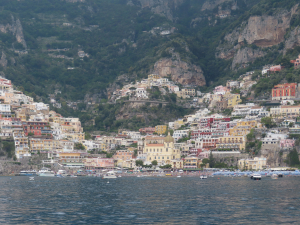
Our unexpected boat ride around the Amalfi Coast gave a view of Positano from the water.
What we didn’t anticipate was that the transportation rules had changed since our driver and Tour Director Andrea F. had checked that morning. The driver was not allowed to re-enter the city to pick us up! Thanks to the fast thinking and resourceful Andrea F., he booked us passage on a boat that cruised the coastline all the way to Sorrento. We scrambled to make the boat’s departure, but this was so much better than riding the bus! Russ thought it was one of the best bonuses of the trip; getting to see the Amalfi Coastline by (calm) water!
where we ate:
When we first arrived to Sorrento, traffic was heavy and our travels brought us into the city later than hoped. Our beloved Tour Director Andrea F. knew a restaurant with a reputation for good food that we might be able to get into last minute as a large group. Most of us joined him. This was Ristorante Tasso, also referred to as Ristorante Pizzeria Tasso. We dined inside.
I appreciated the elegant environment but was less impressed by the quality of the food Russ and I had. Neither of us was particularly hungry but did want a nosh. He ordered a margarita pizza. In a restaurant with pizzeria in its name, we expected more than the bland, nothing-special pie he got. I ordered from the starter menu: a savory tart with pickled and grilled veggies and a wild salad. I imagined that meant a small tart containing veggies and a bit of salad on the side. What I got was a tasteless dry plate-sized cracker with a smattering of pickled veggies and a few bits of mixed greens sitting atop.
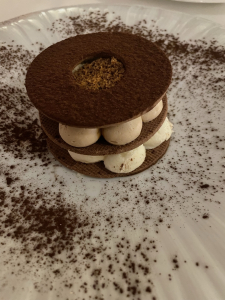
Espresso was poured down the center top hole of this tiramisu at Ristorante Tasso.
We may not have been hungry, but our less-than-appealing dishes left us wanting something more satisfying. We ordered their tiramisu to share. This was as tasty as it was creatively beautiful. There were orbs of cream on two layers of chocolate cookie cracker and topped by a third one dusted with cocoa. The top had an open circle, into which was poured espresso. We thought the service was efficiently brusque. There was neither patience nor friendly spirit from the serving staff. There were others in our group who thought the ravioli and ziti pasta dishes were tasty.
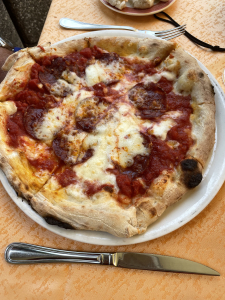
This was one of the pizzas Russ enjoyed the most on this trip and it was at Fauno Bar Sorrento.
Andrea F. had recommended this wonderful restaurant called Fauno Bar Sorrento for an inexpensive lunch. We ate there when the rest of the group toured Pompeii. The casual corner restaurant faced Piazza Tasso and had many outside tables with people vying for an empty space. The restaurant bustled with the vitality of fragrant aromas, tall glasses of wine, beer and limoncello spritzers, and obvious enthusiastic eaters. Hot rolls and breads were placed on the table immediately. It was the first Italian restaurant that automatically gave us a bottle of olive oil for the bread. Russ had a pizza of tomato, mozzarella, and salami that exceeded his expectations. He had a Birra Doppio Malto, an amber beer from Sorrento with the tang of oranges. My limoncello spritzer packed a punch while my minestrone soup thick with vegetables and savory broth provided comfort. Prices were reasonable. Quality of food and service was excellent.
One of the activities I enjoy immensely on these tours is getting to cook with local chefs. I enjoy new ingredients, learning another method of preparation, and then eating our endeavors. That’s one of the reasons I didn’t want to chance going off to Pompeii and Herculaneum and returning late.
Agriturismo Galatea is a restaurant, event center, and cooking school. Wear sturdy shoes as the steep hill down to the working farm can be rocky and slippery. There are pungent smells of farm animals and wild foliage… just a thought if you need to be prepared with an allergy pill. Four generations of family have owned this farm.

A steep path down to restaurant-cooking school-event center Agriturismo Galatea.
They specialize in extra virgin olive oil using just green olives. They have 300 olive trees for pressing into oil and whatever remains at the end of the season may end up as jam. Nothing is wasted. They have Sorrento lemons year-round, which are smaller and juicier than the larger lemons from the Amalfi Coast. Naturally, some of those lemons are used for the limoncello they sell. The bottles can last two years in a freezer.
All the foods they sell are grown and produced on the farm. They make their mozzarella by hand, no machines. Their mozzarella is always braided into ropes. After shaping, the cheese sits in a cold bath for two hours.
Our group was split between two kitchens. We were given instructions for tasks, participated in making gnocchi, tomato sauce, and sauteed escarole, and then we finished the meal with a fig tart. We ate well, drank well, and were able to depart without having to clean up!
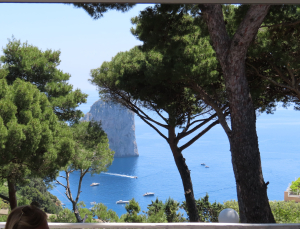
The view from Restorante Il Geranio Capri is gorgeous, whether on the patio or inside.
Restorante ll Geranio Capri in the Gardens of Augustus on the Isle of Capri is where the elegance of the décor perfectly accompanies the scenic views visible from the open terrace and oversized windows that overlook the mixture of bright flora, fauna, and the blue of sea beyond. Service was five-star and the quality of food presentation matched. With our friends Vivian and Dave W. (who we’d first met on another Odysseys Unlimited tour years prior), we shared an appetizer of fresh burrata with five types of tomatoes and arugula. Russ had a fillet with Béarnaise, roasted potatoes and escarole. I had rigafoni (short tubes of pasta) with lobster. The denuded shell decorated the plate. We shared a bottle of 2012 Mauriziozanella. We were each blessed by our server with a glass of limoncello and a plate of three different types of cookies. Overall, a dining experience not to be forgotten.
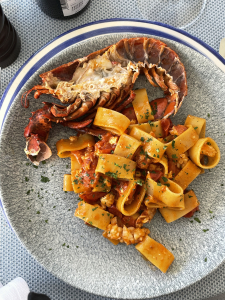
Rigafoni (short tubes) of pasta with lobster at Restorante Il Geranio Capri on the Isle of Capri.
Wrapping up the tour of the Amalfi Coast was the final activity of the tour except for the last night’s group dinner. All we had left to do was pass the COVID rapid test given by an official medical team coming to our hotel for us, a necessity at that time for being able to board a plane home early the next morning. Why was I as nervous as taking a final exam that depended on whether I graduated?
And that’s a story for another day!
*Part 2: GONDALIERS DON’T SING AND NO ITALIAN WEDDING SOUP? A FIRST-TIMER’S DISCOVERY OF THE REAL ITALY (https://karenkuzsel.com/2018/06/16/gondaliers-dont-sing-and-no-italian-wedding-soup-a-first-timers-discovery-of-the-real-italy-2/)
** Part 1: GONDALIERS DON’T SING AND NO ITALIAN WEDDING SOUP? A FIRST-TIMER’S DISCOVERY OF THE REAL ITALY. ((https://karenkuzsel.wordpress.com/tag/grand-canal/)
https://www.faunobar.it/en/index
https://ristorantetasso.com/en/
http://www.agriturismogalatea.com/
https://odysseys-unlimited.com
Karen Kuzsel is a writer-editor based in the Orlando area who specializes in the hospitality, entertainment, meetings & events industries. She is an active member of International Live Events Association and Meeting Professionals International and is now serving on the 2021-2022 MPI Global Advisory Board for Small Business Owners. She is a member of the Society of Professional Journalists. Karen writes about food & wine, spas, destinations, venues, meetings & events. A career journalist, she has owned magazines, written for newspapers, trade publications, radio and TV. As her alter-ego, Natasha, The Psychic Lady, she is a featured entertainer for corporate and social events. Karen@KarenKuzsel.com; www.KarenKuzsel.com; www.ThePsychicLady.com; @karenkuzsel; @thepsychiclady. Food photos for this series by Karen Kuzsel. All other Photos by Russ Wagner, a retired government planner/builder who has a passion for historic architecture, wine, trains, travel and taking photographs.
